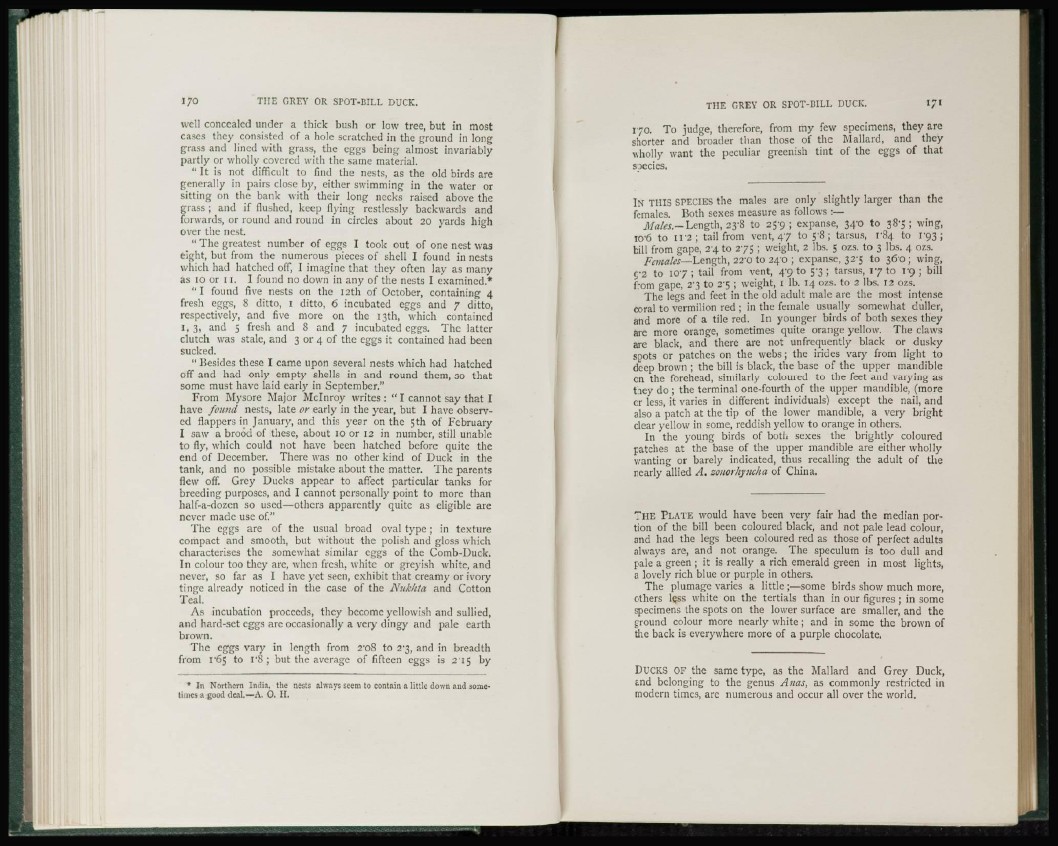
well concealed under a thick bush or low tree, but in most
cases they consisted of a hole scratched in the ground in long
grass and lined with grass, the eggs being almost invariably
partly or wholly covered with the same material.
" I t is not difficult to find the nests, as the old birds are
generally in pairs close by, either swimming in the water or
sitting on the bank with their long necks raised above the
grass; and if flushed, keep flying restlessly backwards and
forwards, or round and round in circles about 20 yards high
over the nest.
" The greatest number of eggs I took out of one nest was
eight, but from the numerous pieces of shell I found in nests
which had hatched off, I imagine that they often lay as many
as 10 or 11. I found no down in any of the nests I examined.*
" I found five nests on the 12th of October, containing 4
fresh eggs, 8 ditto, 1 ditto, 6 incubated eggs and 7 ditto,
respectively, and five more on the 13th, which contained
I, 3, and 5 fresh and 8 and 7 incubated eggs. The latter
clutch was stale, and 3 or 4 of the eggs it contained had been
sucked.
" Besides these I came upon several nests which had hatched
off and had only empty shells in and round them, so that
some must have laid early in September."
From Mysore Major Mclnroy writes : " I cannot say that I
have found nests, late or early in the year, but I have observed
flappers in January, and this year on the 5th of February
I saw a brood of these, about 10 or 12 in number, still unable
to fly, which could not have been hatched before quite the
end of December. There was no other kind of Duck in the
tank, and no possible mistake about the matter. The parents
flew off. Grey Ducks appear to affect particular tanks for
breeding purposes, and I cannot personally point to more than
half-a-dozen so used—others apparently quite as eligible are
never made use of."
The eggs are of the usual broad oval type; in texture
compact and smooth, but without the polish and gloss which
characterises the somewhat similar eggs of the Comb-Duck.
In colour too they arc, when fresh, white or greyish white, and
never, so far as I have yet seen, exhibit that creamy or ivory
tinge already noticed in the case of the Nukkta and Cotton
Teal.
As incubation proceeds, they become yellowish and sullied,
and hard-set eggs are occasionally a very dingy and pale earth
brown.
The eggs vary in length from 2'o8 to 2'3, and in breadth
from 1'65 to I'8 ; but the average of fifteen eggs is 215 by
* In Northern India, the nests always seem to contain a little clown and sometimes
a good deal.—A. 0. H.
1 7 0 . To judge, therefore, from my few specimens, they are
shorter and broader than those of the Mallard, and they
wholly want the peculiar greenish tint of the eggs of that
species,
IN THIS SPECIES the males are only slightly larger than the
females. Both sexes measure as follows :—
Males.—Length, 23'8 to 25-9; expanse, 34-0 to 38-5; wing,
I0'6 to IL2; tail from vent, 4 7 to 5-8 ; tarsus, 1-84 to 1-93 ;
bill from gape, 24 to 275 ; weight, 2 lbs. 5 ozs. to 3 lbs. 4 ozs.
Females—Length, 22'o to 240 ; expanse, 32-5 to 360 ; wing,
9'2 to 107 ; tail from vent, 4^9 to 53 ; tarsus, 1 7 to 19 ; bill
from gape, 2'3 to 2'5 ; weight, 1 lb. 14 ozs. to 2 lbs. 12 ozs.
The legs and feet in the old adult male are the most intense
coral to vermilion red ; in the female usually somewhat duller,
and more of a tile red. In younger birds of both sexes they
are more orange, sometimes quite orange yellow. The claws
are black, and there are not unfrequently black or dusky
spots or patches on the webs; the irides vary from light to
deep brown ; the bill is black, the base of the upper mandible
on the forehead, similarly coloured to the feet and varying as
they do ; the terminal one-fourth of the upper mandible, (more
or less, it varies in different individuals) except the nail, and
also a patch at the tip of the lower mandible, a very bright
clear yellow in some, reddish yellow to orange in others.
In the young birds of both sexes the brightly coloured
patches at the base of the upper mandible are either wholly
wanting or barely indicated, thus recalling the adult of the
nearly allied A. zouorhyncha of China.
THE PLATE would have been very fair had the median portion
of the bill been coloured black, and not pale lead colour,
and had the legs been coloured red as those of perfect adults
always are, and not orange. The speculum is too dull and
pale a green ; it is really a rich emerald green in most lights,
a lovely rich blue or purple in others.
The plumage varies a little ;—some birds show much more,
others less white on the tertials than in our figures ; in some
specimens the spots on the lower surface are smaller, and the
ground colour more nearly white; and in some the brown of
the back is everywhere more of a purple chocolate.
DUCKS OF the same type, as the Mallard and Grey Duck,
and belonging to the genus Anas, as commonly restricted in
modern times, are numerous and occur all over the world.